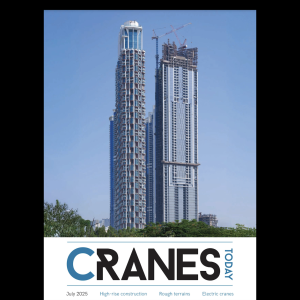This purpose-built office building, which is located in a prominent position directly opposite Great Portland Street Tube Station, is currently undergoing an extensive refurbishment by owners Amsprop. The construction job has built in new air conditioning and an additional sixth floor level, totalling 300 sq m.
Amsprop’s main contractor, Knight Harwood Limited, chose this crane due to its lightweight design, which enabled it to be sited on a temporary steel base which formed part of the roof extension primary steel frame. This allowed the crane to be located above the highest point of the 6th floor extension utilising standard mast sections. Once the crane is removed it will be a relatively easy job to fill in this small section of the buiding to make it watertight.
From this location the crane is being used to lift the structural steelwork from the delivery vehicles and then to distribute them to roof level, where they are being erected to create the main structure for the glazed office suite. The crane is also being used to unload and distribute the building materials required for the interior fit-out on to external staggered loading platforms which are integeral to the fully designed independant scaffolding. This solution enables materials to be transferred into the building, through the existing windows, via the scaffold run-offs. These loading platforms are strategically located at each floor level on the building’s front elevation.
The sixth floor extension incorporates a barrelled circular zinc roof, facade structural glazing with zinc panelled infills and external Metsec wall linings, which are clad in a sto rendered finish. All of the building materials for the building’s new barrelled zinc roof, facade structural glazing and external Metsec wall linings, as well as materials for extensions of existing staircases and lift shafts are being craned in by the LCL 20.1.
According to Steve Callow, the project manager for Knight Harwood Limited, “This hydraulic luffing tower crane was able to minimise the requirement for mobile cranage, which would have caused major difficulties at street level due to the building being on a main traffic route. Had we chosen to use mobile cranes, we would have had to make all the necesssary arrangements with Westminster City Council to partially close off the road every time we had a delivery, thereby causing considerable inconvenience to local traffic, as well as slowing up the build time for the project.
“The LCL20 has been perfect for this project and has proved to be an extremely cost effective approach to distributing and off loading materials on this difficult site. The beauty of this crane is that it is quicker than a traditional lifting beam/goods hoist arrangements as the materials can be accurately placed exactly where they are needed, due to the use of inverters on all the crane’s motions. With a lifting beam/goods hoist arrangement it would not have been possible to distribute the materials required to construct the new sixth floor extension without the use of a mobile crane.
“With the benefit of remote control operation this crane has avoided the requirement for a full time banksman, which has further reduced operational costs. The remote control enables the operator to be positioned by the lift, so that they can see the load at every possible position. He can drive the load wherever he wants it to go to increase operational efficiencies and reduce double handing. The only downside is that this crane has been designed to operate at a 20 metre radius with 1 tonne at 20 metre and so we had to manage every lift accordingly.”
The working radius of this luffing jib crane has been set so that it is able to work within the building’s footprint to avoid interferring with other people’s air space, which was of particular importance on this congested inner city site. This capability is also able to keep the ‘out of service’ radium to a minimum in this confined application.






